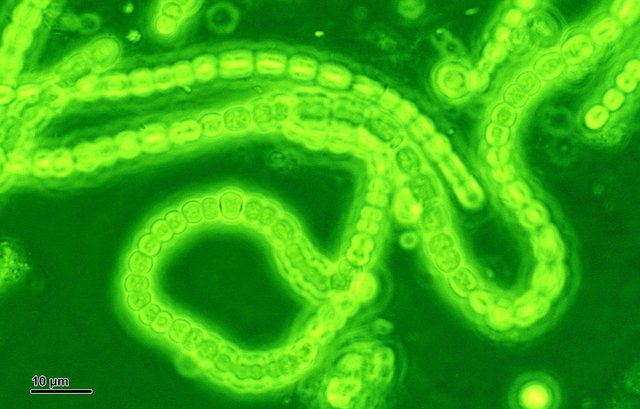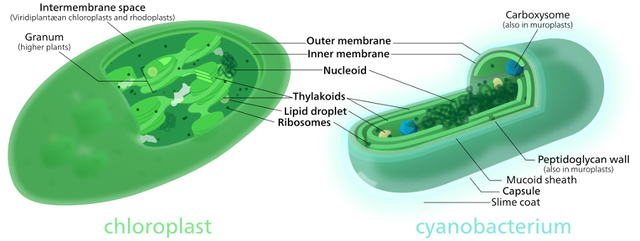The Oxygen Catastrophe
Or: how a single celled organism almost wiped out all life on earth during the first mass-extinction by giving us oxygen.

source: Wikimedia Commons
A couple of days ago I wrote Microbes Are Forever, on the near immortality of certain microbes found in the mud covering the floor of the deep sea, and how different they are from all other life found on the planet. Especially the low energy requirements for these life-forms to exist and their total independence from sunlight makes them remarkable. This is because all other life on earth depends for its energy on sunlight: plants transform carbondioxide and water into sugar and oxygen through photosynthesis. And animals eat these plants, or other animals that eat plants to get their energy; all life as we know it depends on the energy from sunlight, either directly or indirectly. Except for those microbes in the oceans' mud...
I'll now share with you why these microbes are so different: they existed in our oceans billions of years ago, even before the first oxygen-producing plants existed! When we look at the early earth's history, it's a beautiful tale of how life as we know it developed from the earliest single celled organisms; our mud-dwelling microbes or anaerobic cells. These anaerobic cells were the dominant life-form om earth for a billion years.
Back then, approximately three billion years ago, almost the entire planet was still covered with water. This water, the oceans from today, was full of iron and contained almost no oxygen. Above the water, the atmosphere was mostly nitrogen, water-vapor, carbondioxide and methane, but almost no oxygen at all. Then, approximately 2.8 - 2.5 billion years ago, the first photosynthesizing creatures appeared near the water's surface; cyanobacteria, also known as blue-green bacteria. They photosynthesized oxygen from water and carbondioxide.
This oxygen, that was also released into the water of course, was toxic to the anaerobic cells alive back then, and hence the earths first mass-extinction was a fact; most of these early life-forms died and only the ones that literally fled into the mud from the deepest ocean-floors survived. Another effect was that all the iron in the seas began to rust, depositing thick layers of red-brown sediment which can be seen today in archaeological stratification.

Chloroplast-Cyanobacterium comparison - source: Wikimedia Commons
Isn't it wonderful how the very process upon which almost all life depends, the process of producing oxygen with sunlight, long ago was the death of all existing life on earth? Through some genetic mutation some of the cells developed the ability to capture energy directly from sunlight by photosynthesis. There were no animals yet, so carbondioxide levels kept reducing while oxygen levels kept rising, so the cyanobacteria also died off in massive numbers as they consumed all carbondioxide with their photosynthesis; this is why there's several bands of red-brown layers in the earths crust as the raining down of rusted iron lasted almost a billion years in several stages.
One of the hypotheses about the early evolution af life is that animals evolved to counter balance the oxygen production of plants; with a high oxygen level in the atmosphere everything would spontaneously burn with the lightest spark. Also the higher oxygen levels back then explain why there were so many extremely large animals and insects.
I hope you find this as interesting as I do. If so, here's a ten minute video that explains all of this and something extra: there's a possibility that the chloroplasts, the organelles inside plant-cells responsible for photosynthesis, are in fact directly descendant from the cyanobacteria from two and a half billion years ago!
Evolution and Oxygen
As always I want to thank you, dear reader, for visiting my blog and showing your support. It cannot be overstated how you make Steemit a great place to be :-)

Recent articles you might be interested in:
| Latest article >>>>>>>>>>> | What We Believe Matters |
|---|---|
| Microbes Are Forever | The First Casualty Of War |
| God Wants You Dead. Really. | Polarization Bubble |
| It's A MAD World | STEEM Is Still Doing Great! |

Thanks for stopping by and reading. If you really liked this content, if you disagree (or if you do agree), please leave a comment. Of course, upvotes, follows, resteems are all greatly appreciated, but nothing brings me and you more growth than sharing our ideas. It's what Steemit is made for!


Just for Full Disclosure, I'm invested in these crypto-currencies:
Bitcoin | Litecoin | EOS | OmiseGo | FunFair | KIN | Pillar | DENT | Polymath | XDCE | 0x | Decred | Ethereum | Carmel | XYO
As your wish to see me again from last reply, I am back here. Haha
Last time was about something general and philosophy, but this article is about science.... whish is tooooooo difficult for me... lol
I will come back for your philosophy articles again. :)
Have a good weekend :)
Thanks so much for sticking with me @jisoooh0202 :-)
Too difficult? Well, then I'll just have to do a better job explaining! Thanks so much for that input, that can really help me. I truly want to be able to write about anything at all in a way that anybody should be able to understand. But I'm learning, and only be doing this for four months now. I want to get better at this, so this is valuable input for me and I want to thank you for that to :-) <3
You have a great weekend to, @jisoooh0202!
Consider following the @steemSTEM guidelines and using the #steemstem tag next time. You may be rewarded with a good upvote from @steemSTEM.
Thanks so much for the tip, @tobixen. And thanks for thinking my articles would measure up to the quality I usually find at Steemstem. I did get upvotes from that great group of people in the past, but whenever I see the articles that make it into their weekly curation post, I suddenly feel very humble :-) There's some truly great and smart writers active over there, which has made me hesitant to use the tag... But maybe I'm over reacting here: I've been known to do that on occasion. Also I struggle with the 5 tag limit: there's so many well intending groups active on Steemit and if we would use all of them, there would be no room left to make the post the least bit findable. And findability is one of Steemit's weak points as it is...
But having said all that: I'm going to follow your advice and start putting the steemstem tag in my science-related posts again. Thanks again, @tobixen, it's much appreciated! :-)